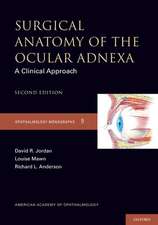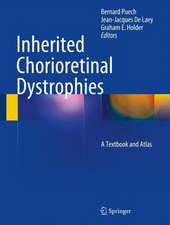Atlas of Posterior Fundus Changes in Pathologic Myopia
Autor Takashi Tokoroen Limba Engleză Paperback – 19 sep 2011
| Toate formatele și edițiile | Preț | Express |
|---|---|---|
| Paperback (1) | 371.66 lei 6-8 săpt. | |
| Springer – 19 sep 2011 | 371.66 lei 6-8 săpt. | |
| Hardback (1) | 374.28 lei 38-44 zile | |
| Springer – dec 1998 | 374.28 lei 38-44 zile |
Preț: 371.66 lei
Preț vechi: 391.22 lei
-5% Nou
Puncte Express: 557
Preț estimativ în valută:
71.12€ • 74.45$ • 58.84£
71.12€ • 74.45$ • 58.84£
Carte tipărită la comandă
Livrare economică 05-19 aprilie
Preluare comenzi: 021 569.72.76
Specificații
ISBN-13: 9784431680185
ISBN-10: 4431680187
Pagini: 212
Ilustrații: VIII, 203 p.
Dimensiuni: 210 x 279 x 11 mm
Greutate: 0.49 kg
Ediția:Softcover reprint of the original 1st ed. 1998
Editura: Springer
Colecția Springer
Locul publicării:Tokyo, Japan
ISBN-10: 4431680187
Pagini: 212
Ilustrații: VIII, 203 p.
Dimensiuni: 210 x 279 x 11 mm
Greutate: 0.49 kg
Ediția:Softcover reprint of the original 1st ed. 1998
Editura: Springer
Colecția Springer
Locul publicării:Tokyo, Japan
Public țintă
Professional/practitionerCuprins
Preface.- Acknowledgments.- 1 Criteria for Diagnosis of Pathologic Myopia.- 2 Methods of Examining the Posterior Pole of the Fundus.- 2.1 Indirect Binocular Microscopy.- 2.2 Slit Lamp Biomicroscopy.- 2.3 Fundus Photography.- 2.4 Fundus Angiography.- 3 Types of Fundus Changes in the Posterior Pole.- 3.1 Tessellated Fundus and Crescent.- 3.2 Diffuse Chorioretinal Atrophy (D).- 3.3 Patchy Chorioretinal Atrophy (P).- 3.4 Macular Hemorrhage (H).- 4 Explanatory Factors of Chorioretinal Atrophy.- 4.1 Percentage of Chorioretinal Atrophy in Each Age Group.- 4.2 Percentage of Eyes with Chorioretinal Atrophy in Each Axial Length Group.- 4.3 Percentage of Chorioretinal Atrophy With or Without Posterior Staphyloma.- 5 Visual Acuity and Chorioretinal Atrophy.- 5.1 Distribution of Visual Acuity and Axial Length.- 5.2 Percentage of Diffuse Chorioretinal Atrophy by Visual Acuity.- 5.3 Percentage of Patchy Atrophy by Visual Acuity.- 5.4 Percentage of Eyes with Macular Hemorrhage.- 5.5 Visual Acuity and Area of Peripapillary Atrophy.- 6 Progression of Chorioretinal Atrophy in Cases of Long-Term Observation.- 6.1 Diffuse Chorioretinal Atrophy.- 6.2 Patchy Atrophy.- 6.3 Choroidal Neovascular Membrane.- 7 Progression of Fundus Changes in the Posterior Pole.- 7.1 Classification of Stage of Fundus Change in the Posterior Pole.- Appendix: Relationship Between Fundus Changes in the Posterior Pole and Visual Acuity.- A.1 Factors That Can Explain the Present Visual Acuity.- A.2 Prognosis of Visual Acuity According to Multivariant Analysis by Quantification II.- References.- Cases of Chorioretinal Atrophy.- Diffuse Chorioretinal Atrophy Cases 1–15.- Lacquer Crack Lesions and Simple Bleeding Cases 16–23.- Patchy Chorioretinal Atrophy Cases 24–37.- Myopic Choroidal Neovascularization (Fuchs’Spot) Cases 38–52.
Caracteristici
Presenting of more than 50 different cases studies * Generous use of full-color photographs to show in detail the course of fundus changes











